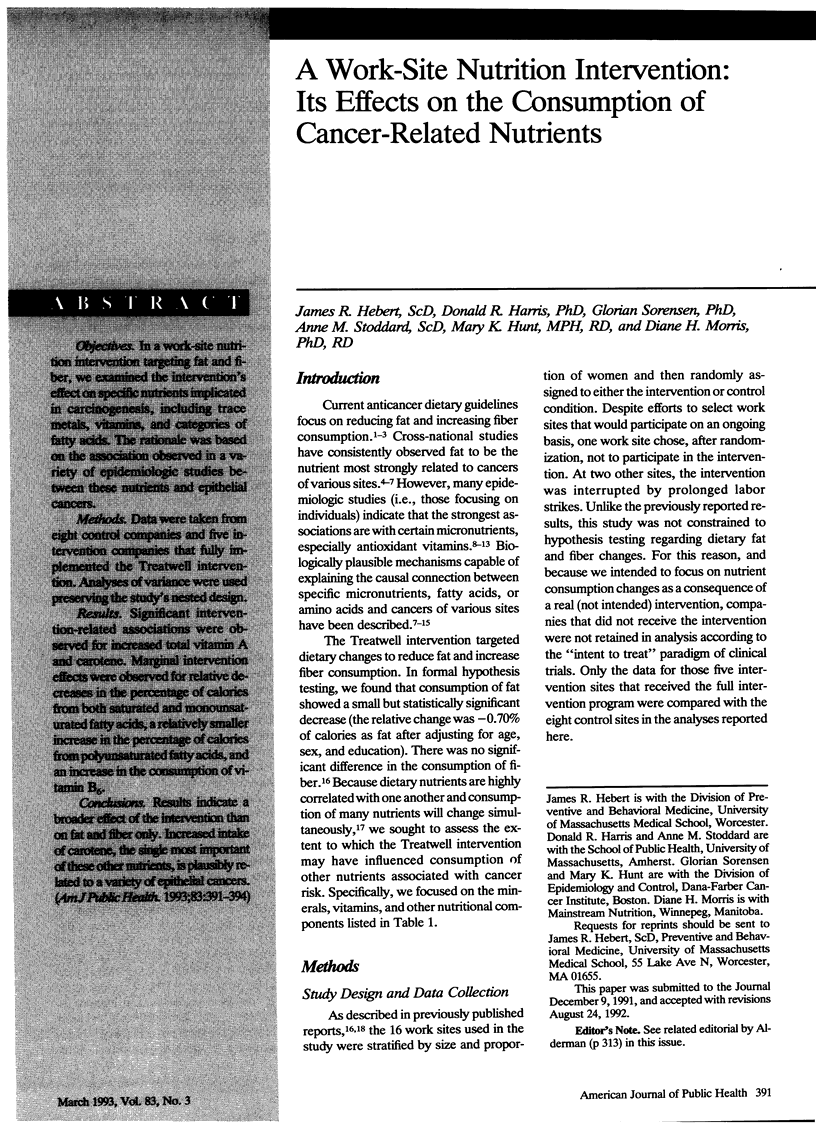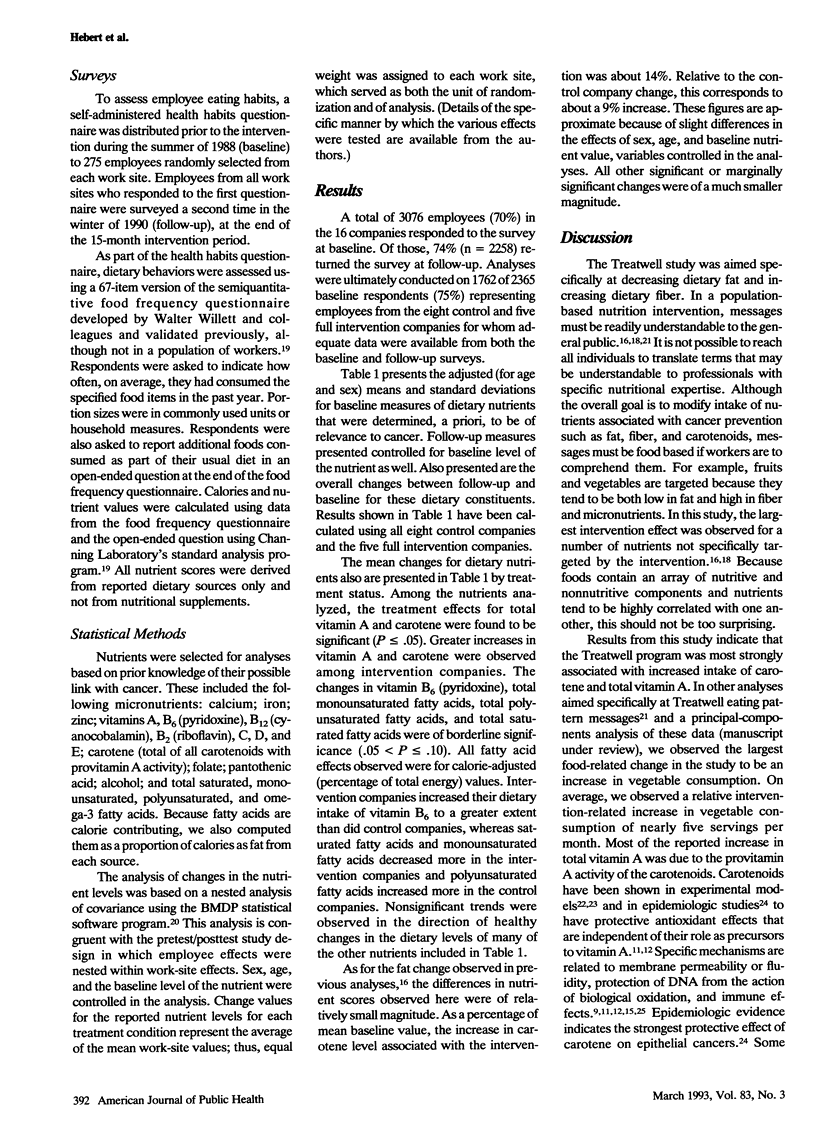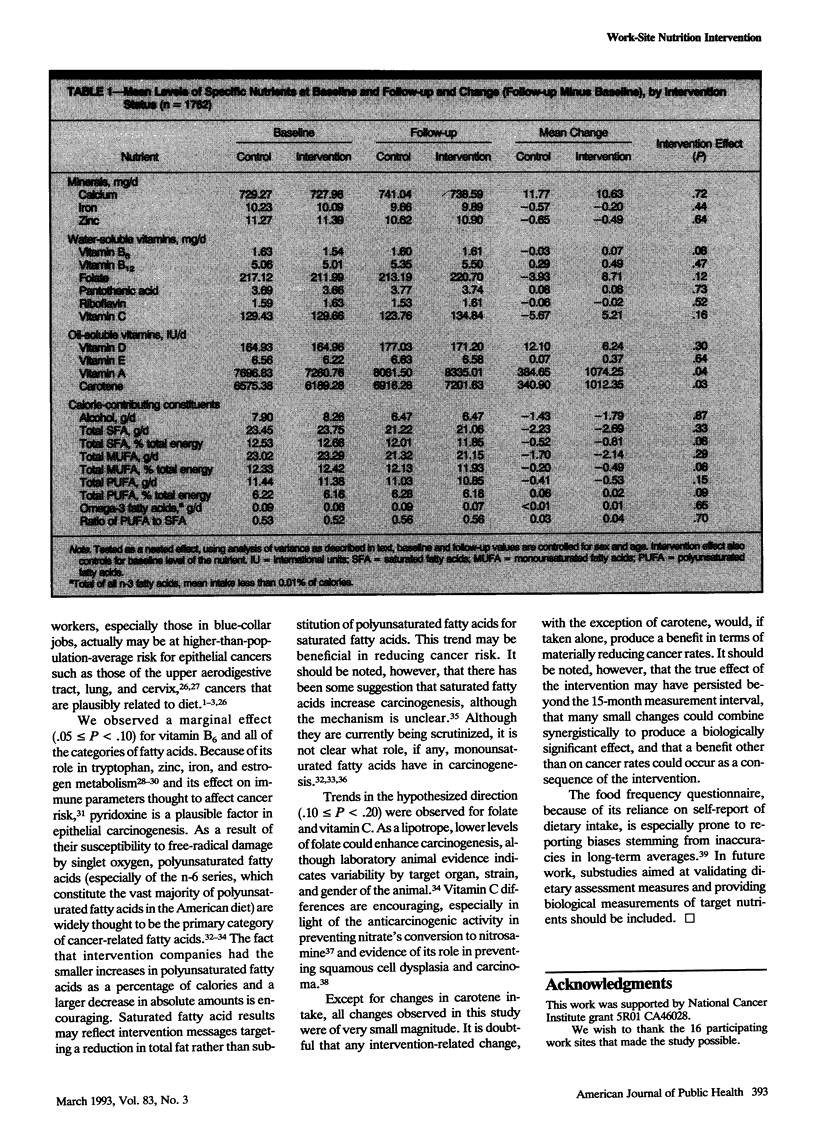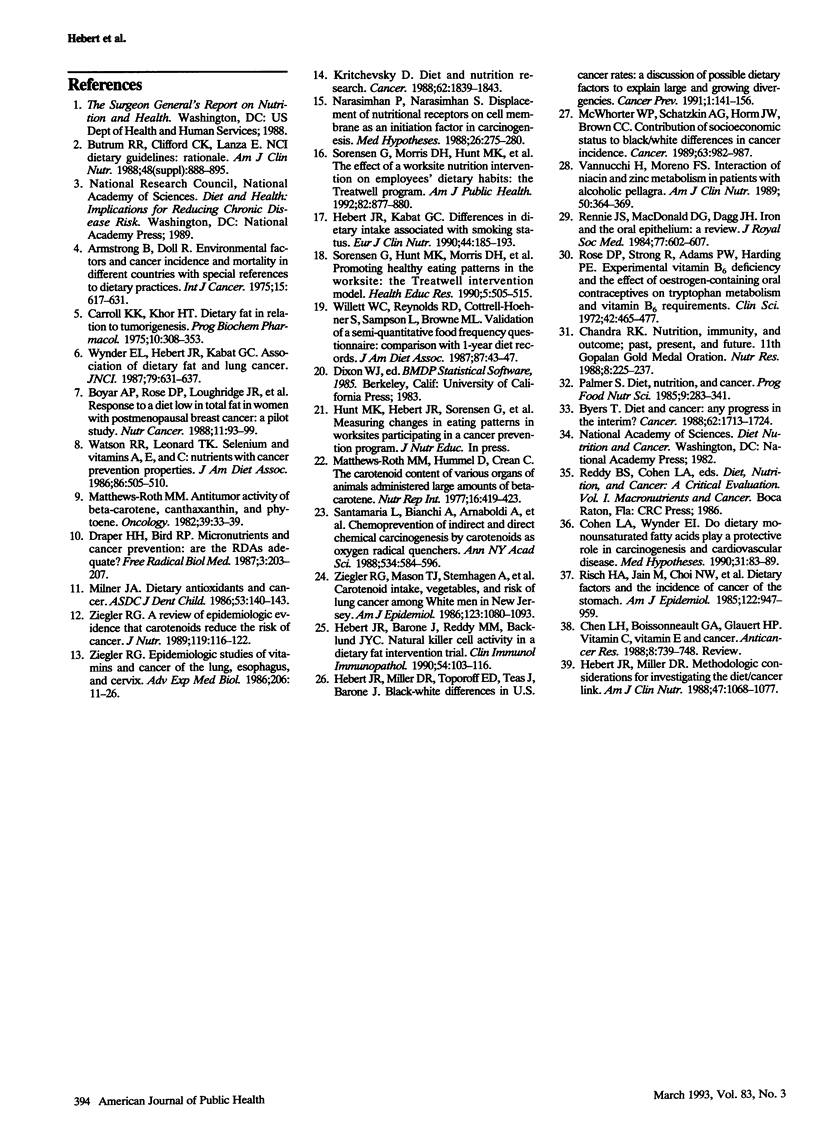Abstract
OBJECTIVES. In a work-site nutrition intervention targeting fat and fiber, we examined the intervention's effect on specific nutrients implicated in carcinogenesis, including trace metals, vitamins, and categories of fatty acids. The rationale was based on the association observed in a variety of epidemiologic studies between these nutrients and epithelial cancers. METHODS. Data were taken from eight control companies and five intervention companies that fully implemented the Treatwell intervention. Analyses of variance were used preserving the study's nested design. RESULTS. Significant intervention-related associations were observed for increased total vitamin A and carotene. Marginal intervention effects were observed for relative decreases in the percentage of calories from both saturated and monounsaturated fatty acids, a relatively smaller increase in the percentage of calories from polyunsaturated fatty acids, and an increase in the consumption of vitamin B6. CONCLUSIONS. Results indicate a broader effect of the intervention than on fat and fiber only. Increased intake of carotene, the single most important of these other nutrients, is plausibly related to a variety of epithelial cancers.
Full text
PDF



Selected References
These references are in PubMed. This may not be the complete list of references from this article.
- Armstrong B., Doll R. Environmental factors and cancer incidence and mortality in different countries, with special reference to dietary practices. Int J Cancer. 1975 Apr 15;15(4):617–631. doi: 10.1002/ijc.2910150411. [DOI] [PubMed] [Google Scholar]
- Boyar A. P., Rose D. P., Loughridge J. R., Engle A., Palgi A., Laakso K., Kinne D., Wynder E. L. Response to a diet low in total fat in women with postmenopausal breast cancer: a pilot study. Nutr Cancer. 1988;11(2):93–99. doi: 10.1080/01635588809513975. [DOI] [PubMed] [Google Scholar]
- Butrum R. R., Clifford C. K., Lanza E. NCI dietary guidelines: rationale. Am J Clin Nutr. 1988 Sep;48(3 Suppl):888–895. doi: 10.1093/ajcn/48.3.888. [DOI] [PubMed] [Google Scholar]
- Byers T. Diet and cancer. Any progress in the interim? Cancer. 1988 Oct 15;62(8 Suppl):1713–1724. doi: 10.1002/1097-0142(19881015)62:1+<1713::aid-cncr2820621309>3.0.co;2-w. [DOI] [PubMed] [Google Scholar]
- Carroll K. K., Khor H. T. Dietary fat in relation to tumorigenesis. Prog Biochem Pharmacol. 1975;10:308–353. [PubMed] [Google Scholar]
- Chen L. H., Boissonneault G. A., Glauert H. P. Vitamin C, vitamin E and cancer (review). Anticancer Res. 1988 Jul-Aug;8(4):739–748. [PubMed] [Google Scholar]
- Cohen L. A., Wynder E. I. Do dietary monounsaturated fatty acids play a protective role in carcinogenesis and cardiovascular disease? Med Hypotheses. 1990 Feb;31(2):83–89. doi: 10.1016/0306-9877(90)90002-v. [DOI] [PubMed] [Google Scholar]
- Draper H. H., Bird R. P. Micronutrients and cancer prevention: are the RDAs adequate? Free Radic Biol Med. 1987;3(3):203–207. doi: 10.1016/0891-5849(87)90007-4. [DOI] [PubMed] [Google Scholar]
- Hebert J. R., Barone J., Reddy M. M., Backlund J. Y. Natural killer cell activity in a longitudinal dietary fat intervention trial. Clin Immunol Immunopathol. 1990 Jan;54(1):103–116. doi: 10.1016/0090-1229(90)90010-n. [DOI] [PubMed] [Google Scholar]
- Hebert J. R., Kabat G. C. Differences in dietary intake associated with smoking status. Eur J Clin Nutr. 1990 Mar;44(3):185–193. [PubMed] [Google Scholar]
- Hebert J. R., Miller D. R. Methodologic considerations for investigating the diet-cancer link. Am J Clin Nutr. 1988 Jun;47(6):1068–1077. doi: 10.1093/ajcn/47.6.1068. [DOI] [PubMed] [Google Scholar]
- Kritchevsky D. Diet and nutrition research. Cancer. 1988 Oct 15;62(8 Suppl):1839–1843. doi: 10.1002/1097-0142(19881015)62:1+<1839::aid-cncr2820621327>3.0.co;2-d. [DOI] [PubMed] [Google Scholar]
- Mathews-Roth M. M. Antitumor activity of beta-carotene, canthaxanthin and phytoene. Oncology. 1982;39(1):33–37. doi: 10.1159/000225601. [DOI] [PubMed] [Google Scholar]
- McWhorter W. P., Schatzkin A. G., Horm J. W., Brown C. C. Contribution of socioeconomic status to black/white differences in cancer incidence. Cancer. 1989 Mar 1;63(5):982–987. doi: 10.1002/1097-0142(19890301)63:5<982::aid-cncr2820630533>3.0.co;2-i. [DOI] [PubMed] [Google Scholar]
- Milner J. A. Dietary antioxidants and cancer. ASDC J Dent Child. 1986 Mar-Apr;53(2):140–143. [PubMed] [Google Scholar]
- Narasimhan P., Narasimhan S. Displacement of nutritional receptors on cell membrane as an initiation factor in carcinogenesis. Med Hypotheses. 1988 Aug;26(4):275–280. doi: 10.1016/0306-9877(88)90134-x. [DOI] [PubMed] [Google Scholar]
- Palmer S. Diet, nutrition, and cancer. Prog Food Nutr Sci. 1985;9(3-4):283–341. [PubMed] [Google Scholar]
- Rennie J. S., MacDonald D. G., Dagg J. H. Iron and the oral epithelium: a review. J R Soc Med. 1984 Jul;77(7):602–607. doi: 10.1177/014107688407700714. [DOI] [PMC free article] [PubMed] [Google Scholar]
- Risch H. A., Jain M., Choi N. W., Fodor J. G., Pfeiffer C. J., Howe G. R., Harrison L. W., Craib K. J., Miller A. B. Dietary factors and the incidence of cancer of the stomach. Am J Epidemiol. 1985 Dec;122(6):947–959. doi: 10.1093/oxfordjournals.aje.a114199. [DOI] [PubMed] [Google Scholar]
- Rose D. P., Strong R., Adams P. W., Harding P. E. Experimental vitamin B 6 deficiency and the effect of oestrogen-containing oral contraceptives on tryptophan metabolism and vitamin B 6 requirements. Clin Sci. 1972 Apr;42(4):465–477. doi: 10.1042/cs0420465. [DOI] [PubMed] [Google Scholar]
- Santamaria L., Bianchi A., Arnaboldi A., Ravetto C., Bianchi L., Pizzala R., Andreoni L., Santagati G., Bermond P. Chemoprevention of indirect and direct chemical carcinogenesis by carotenoids as oxygen radical quenchers. Ann N Y Acad Sci. 1988;534:584–596. doi: 10.1111/j.1749-6632.1988.tb30149.x. [DOI] [PubMed] [Google Scholar]
- Sorensen G., Morris D. M., Hunt M. K., Hebert J. R., Harris D. R., Stoddard A., Ockene J. K. Work-site nutrition intervention and employees' dietary habits: the Treatwell program. Am J Public Health. 1992 Jun;82(6):877–880. doi: 10.2105/ajph.82.6.877. [DOI] [PMC free article] [PubMed] [Google Scholar]
- Vannucchi H., Moreno F. S. Interaction of niacin and zinc metabolism in patients with alcoholic pellagra. Am J Clin Nutr. 1989 Aug;50(2):364–369. doi: 10.1093/ajcn/50.2.364. [DOI] [PubMed] [Google Scholar]
- Watson R. R., Leonard T. K. Selenium and vitamins A, E, and C: nutrients with cancer prevention properties. J Am Diet Assoc. 1986 Apr;86(4):505–510. [PubMed] [Google Scholar]
- Willett W. C., Reynolds R. D., Cottrell-Hoehner S., Sampson L., Browne M. L. Validation of a semi-quantitative food frequency questionnaire: comparison with a 1-year diet record. J Am Diet Assoc. 1987 Jan;87(1):43–47. [PubMed] [Google Scholar]
- Wynder E. L., Hebert J. R., Kabat G. C. Association of dietary fat and lung cancer. J Natl Cancer Inst. 1987 Oct;79(4):631–637. [PubMed] [Google Scholar]
- Ziegler R. G. A review of epidemiologic evidence that carotenoids reduce the risk of cancer. J Nutr. 1989 Jan;119(1):116–122. doi: 10.1093/jn/119.1.116. [DOI] [PubMed] [Google Scholar]
- Ziegler R. G. Epidemiologic studies of vitamins and cancer of the lung, esophagus, and cervix. Adv Exp Med Biol. 1986;206:11–26. doi: 10.1007/978-1-4613-1835-4_3. [DOI] [PubMed] [Google Scholar]
- Ziegler R. G., Mason T. J., Stemhagen A., Hoover R., Schoenberg J. B., Gridley G., Virgo P. W., Fraumeni J. F., Jr Carotenoid intake, vegetables, and the risk of lung cancer among white men in New Jersey. Am J Epidemiol. 1986 Jun;123(6):1080–1093. doi: 10.1093/oxfordjournals.aje.a114336. [DOI] [PubMed] [Google Scholar]


